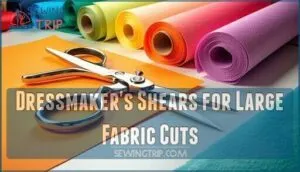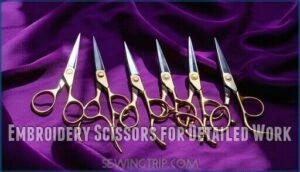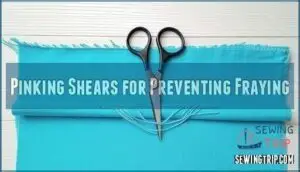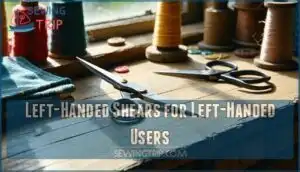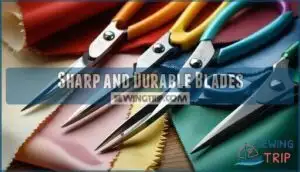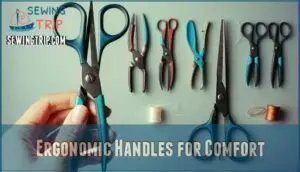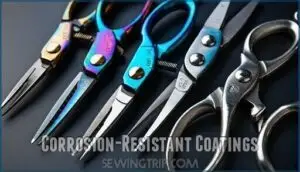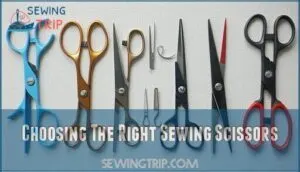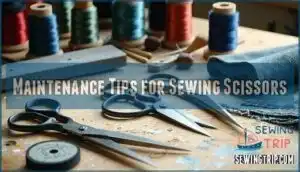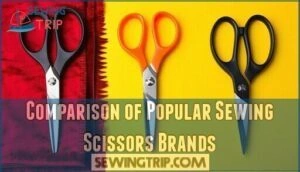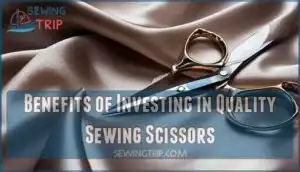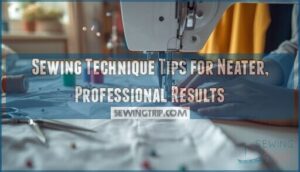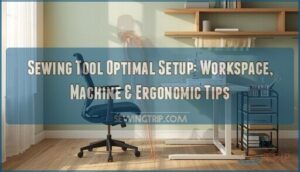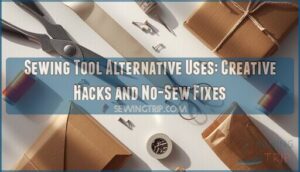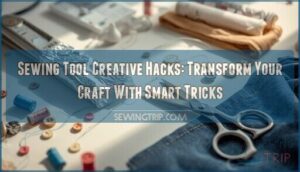This site is supported by our readers. We may earn a commission, at no cost to you, if you purchase through links.
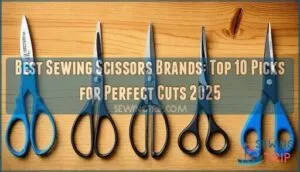 When you’re hunting for the best sewing scissors brands, you’ll want to focus on the proven performers that sewists swear by.
When you’re hunting for the best sewing scissors brands, you’ll want to focus on the proven performers that sewists swear by.
Gingher leads the pack with precision German engineering, while Fiskars offers reliable comfort at budget-friendly prices.
Kai brings Japanese craftsmanship with razor-sharp edges that slice through fabric like butter.
Havel’s specializes in ergonomic designs that won’t cramp your hands during marathon cutting sessions.
Don’t overlook Kretzer, Mundial, and Wiss—these workhorses deliver professional-grade performance that’ll outlast your current project pile.
Each brand brings unique strengths, from corrosion resistance to specialized blade angles that transform tedious cutting into smooth, satisfying snips.
Table Of Contents
- Key Takeaways
- Types of Sewing Scissors and Shears
- Key Features of Quality Sewing Scissors
- Top 10 Best Sewing Scissors Brands
- 1. Guggenhein Professional Tailor Shears IX
- 2. Karen Buckley Perfect Purple Scissors
- 3. Havel’s Snip Eze Embroidery Scissors
- 4. Tula Pink Curved EZ Snips 5
- 5. Fiskars Easy Action Rag Quilt Snip
- 6. Kai 8 inch Pinking Shears
- 7. Gingher Embroidery Scissors Sharp Smooth Cuts
- 8. Gingher 8 inch Fabric Scissors
- 9. Kai V5165P Pink Sewing Scissors
- 10. Loctite Blue 242 Threadlocker Glue
- Choosing The Right Sewing Scissors
- Maintenance Tips for Sewing Scissors
- Comparison of Popular Sewing Scissors Brands
- Benefits of Investing in Quality Sewing Scissors
- Frequently Asked Questions (FAQs)
- Conclusion
Key Takeaways
- Choose scissors that match your hand size and dominant hand – Left-handed sewers need specialized reversed blades, while smaller hands require proportionally sized ergonomic handles for proper control and reduced fatigue.
- Invest in quality blade materials for long-term value – High-carbon steel blades from brands like Gingher and Kai stay sharp longer and cut cleaner than budget alternatives, while stainless steel offers excellent corrosion resistance.
- Match scissor types to your specific sewing tasks – Use 8-10 inch dressmaker’s shears for large fabric cuts, embroidery scissors for detailed work, and pinking shears to prevent fraying on raw edges.
- Maintain your scissors properly to extend their lifespan – Clean blades after each use, store them in protective cases, and sharpen them every 6-12 months to keep your investment performing like new for decades.
Types of Sewing Scissors and Shears
You’ll discover four essential types of sewing scissors, each designed for specific tasks that make your projects easier and more precise.
Understanding these categories helps you choose the right tool for cutting fabric layers, trimming delicate details, preventing fraying, or accommodating your dominant hand, which is crucial for complete concepts.
Dressmaker’s Shears for Large Fabric Cuts
You’ll typically reach for dressmaking shears when tackling large fabric pieces and multiple layers.
These powerhouse fabric scissors feature ideal blade length between 8-10 inches, giving you smooth, continuous cuts across yards of material.
The substantial shears weight impact provides stability, while handle ergonomics reduce hand fatigue during extended cutting sessions.
Position your cutting table height properly to maximize these tailor scissors‘ effectiveness.
Many retailers offer dressmaking shear options to choose from for your specific needs.
Embroidery Scissors for Detailed Work
When you’re crafting intricate appliqué work or trimming jump threads, embroidery scissors become your precision cutting allies.
These detail scissors feature sharp, pointed tips and compact designs that navigate tight spaces with surgical accuracy.
- Blade Curvature: Curved blades reach into embroidery hoops effortlessly
- Handle Ergonomics: Lightweight construction reduces hand fatigue during extended sessions
- Portability: Compact size makes them perfect travel companions
The best sewing scissors for embroidery work combine thread snips functionality with exceptional control, letting you tackle delicate fabrics without accidentally cutting your masterpiece.
Some prefer models with bent blade designs for even greater precision.
Pinking Shears for Preventing Fraying
When you’re battling fabric fraying, pinking shears become your secret weapon.
These specialized fabric scissors create a distinctive zigzag edge that prevents unraveling threads.
The serrated blades work magic on curved seams, making notching easier while reducing bulk.
Different fabric types respond uniquely to the angled cuts – lightweight cottons benefit most, while heavy denim may require multiple passes.
Quality pinking shears from trusted sewing scissors brands deliver consistent blade angles for professional results.
Left-Handed Shears for Left-Handed Users
Left-handed sewers often struggle with traditional sewing scissors brands because standard blade reversal doesn’t work for them.
Left handed scissors feature reversed blades and ergonomic handles designed specifically for southpaws.
The cutting efficiency improves dramatically when your dominant hand naturally guides the top blade.
Quality lefthanded shears include comfort grips that reduce hand fatigue during extended projects.
Ergonomic design makes all the difference for precise cuts and comfortable use.
Key Features of Quality Sewing Scissors
When you’re shopping for sewing scissors, you’ll want to focus on three essential features that separate quality tools from cheap alternatives.
Sharp, durable blades made from high-carbon or stainless steel will give you clean cuts that won’t fray your fabric.
While ergonomic handles reduce hand fatigue during long sewing sessions.
Sharp and Durable Blades
Without sharp, durable blades, your sewing scissors become frustrating tools that crush fabric instead of cutting cleanly.
The best sewing scissors feature high-carbon steel or stainless steel construction that maintains razor-sharp edges through countless projects, ensuring precise cuts every time.
- High-carbon steel blades slice through multiple fabric layers like butter, maintaining their edge longer than cheaper alternatives
- Stainless steel construction resists rust and corrosion, keeping your investment protected in humid sewing rooms
- Micro-serrated edges grip slippery fabrics like silk and satin, preventing annoying fabric slippage during cuts
- Titanium-coated blades offer superior edge retention and corrosion resistance, staying sharp three times longer than uncoated steel
- Adjustable tension screws allow you to fine-tune blade alignment, ensuring smooth cuts and extending scissor lifespan substantially
Ergonomic Handles for Comfort
While sharp blades handle the cutting, your hands need proper support during extended sewing sessions.
Handle Materials like rubber grips and plastic designs directly impact your comfort level.
Poor Grip Design leads to Hand Fatigue quickly, especially during quilting projects.
Smart Weight Distribution prevents strain, while User Preference determines your ideal handle shape for the best sewing scissors experience.
| Feature | Standard Handles | Ergonomic Handles | Impact on Comfort |
|---|---|---|---|
| Grip texture | Smooth metal/plastic | Textured rubber/soft materials | Reduces slipping, increases control |
| Weight distribution | Top-heavy design | Balanced throughout handle | Minimizes wrist strain during cuts |
| Finger positioning | Basic loops | Contoured finger rests | Natural hand position, less fatigue |
| Handle width | One-size approach | Adjustable or varied sizes | Accommodates different hand sizes |
| Material cushioning | Hard surfaces | Padded or soft-grip coating | Prevents pressure points, blisters |
Corrosion-Resistant Coatings
Premium sewing scissors feature protective coatings that shield your investment from rust and corrosion.
These specialized treatments extend blade life substantially, making your scissors perform consistently for years.
Common coating materials include:
- Titanium coating – Ultra-durable surface protection for stainless steel blades
- Bluing treatment – Traditional rust-resistant finish for carbon steel
- Chrome plating – Affordable corrosion barrier with smooth cutting action
- Ceramic coating – Advanced non-stick surface reducing friction
Top 10 Best Sewing Scissors Brands
You’ll discover the top-rated sewing scissors brands that deliver professional-quality cuts for every project.
These carefully selected brands offer reliable performance, durability, and precision that’ll make your sewing tasks easier and more enjoyable.
1. Guggenhein Professional Tailor Shears IX
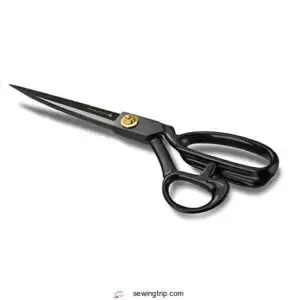
Anyone who’s serious about sewing knows that quality scissors make all the difference.
The Guggenhein Professional Tailor Shears IX delivers exceptional performance with high carbon steel blades that maintain razor-sharp edges through countless projects.
At 9 inches long, these shears cut smoothly through multiple fabric layers, from delicate silk to heavy denim.
The ergonomic rubber-coated handles reduce hand fatigue during extended cutting sessions.
With a lifetime warranty and impressive 58 HRC hardness rating, they’re built to last, making them a reliable choice for professionals and serious sewers who demand high carbon steel blades.
Best For: Professionals and serious hobbyists who want durable, sharp shears for a variety of fabrics.
- High carbon steel blades stay sharp and cut smoothly through multiple layers.
- Ergonomic, rubber-coated handles reduce hand fatigue.
- Lifetime warranty with responsive customer service.
- Only suits right-handed users (standard model).
- Occasional oiling needed to prevent rust.
- Some users note manufacturing is in China, not the U.S.
2. Karen Buckley Perfect Purple Scissors
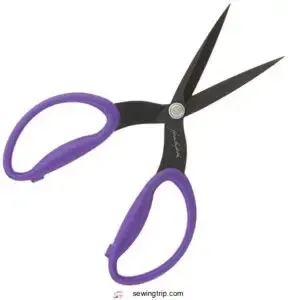
With micro-serrated blades that grip fabric like tiny teeth, Karen Kay Buckley’s Perfect Purple Scissors deliver unmatched precision for quilters and sewers.
You’ll cut through eight layers of cotton without fraying thanks to the innovative serration technology that pulls fabric inward rather than pushing it away.
The cushioned handles work perfectly for both righties and lefties, reducing hand fatigue during marathon sewing sessions.
These lightweight scissors maintain razor sharpness right to the tip, making corner cuts and detailed work effortless, with the added benefit of being suitable for marathon sewing sessions.
Best For: Quilters, sewing enthusiasts, and fabric crafters who need precise, clean cuts without fraying, even through multiple layers.
- Micro-serrated blades grip fabric for controlled, fray-free cutting.
- Cushioned, ambidextrous handles reduce hand fatigue during long use.
- Maintains sharpness to the tip for detailed cuts and corner work.
- Only includes one size, limiting options for different project needs.
- Requires regular cleaning and oiling to preserve blade quality.
- Pricier than some standard scissors, given imported high-quality construction.
3. Havel’s Snip Eze Embroidery Scissors
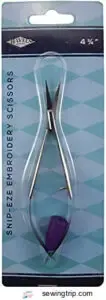
When you’re working on delicate embroidery projects, these lightweight snips become your best friend.
The curved tips slip easily under your presser foot, letting you snip threads without missing a beat.
You’ll love the gentle squeeze action that won’t tire your hands, even during marathon stitching sessions.
The sharp stainless steel blades cut cleanly through thread without fraying, while the safety cap keeps everything protected in your sewing kit.
Perfect for both righties and lefties.
Best For: Those who want precise, comfortable snipping for embroidery, quilting, or sewing—especially if they have hand fatigue or arthritis.
- Sharp curved tips allow for accurate, close thread cutting without damaging fabric
- Gentle squeeze action reduces hand fatigue and is easy for arthritic hands
- Ambidextrous, lightweight, and includes a safety cap for easy storage
- Safety cap can be easy to misplace
- May require adjustment for those used to traditional scissors
- Premium price compared to basic snips
4. Tula Pink Curved EZ Snips 5

When precision meets portability, these titanium-coated curved snips become your best friend for detail work.
The 5-inch micro-serrated blade grips threads without slipping, while the spring-action handles reduce hand fatigue during marathon sewing sessions.
You’ll love how easily they slip under presser feet and navigate tight embroidery hoops.
Made from German stainless steel, they’re lightweight yet durable enough for users with arthritis.
Perfect for needle felting, beadwork, and thread trimming where accuracy matters most.
Best For: Quilters, embroiderers, and crafters who need precise, comfortable snips that fit into tight spaces and are easy on the hands.
- Micro-serrated, curved blade provides clean, snag-free cuts even in tricky spots.
- Lightweight, spring-action handles reduce hand fatigue, making them great for long sessions and users with arthritis.
- Durable, high-quality German stainless steel construction ensures long-lasting sharpness.
- Curved blade may not be ideal for general cutting or trimming thick materials.
- Small size limits use to fine detail work rather than larger fabric tasks.
- Requires occasional maintenance (cleaning and oiling) to keep in top condition.
5. Fiskars Easy Action Rag Quilt Snip
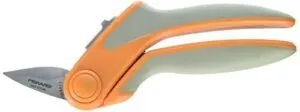
Spring-loaded scissors revolutionize rag quilting by eliminating hand fatigue during repetitive cuts.
You’ll love how these snips automatically open after each cut, reducing strain while maintaining precision through multiple fabric layers.
The serrated edge grips slippery materials like silk, while the contoured handle keeps fabric flat for accurate tabletop cutting.
With stainless steel blades cutting up to eight layers of cotton and a lifetime warranty, they’re perfect for extensive quilting projects requiring hundreds of quick, clean snips, making them ideal for extensive quilting projects.
Best For: Quilters, sewists, and crafters seeking fast, fatigue-free cutting of dense or multiple fabric layers, especially for rag quilting projects.
- Reduces hand strain and fatigue with spring-action handle, making it ideal for repetitive cutting tasks.
- Serrated stainless steel blades cut cleanly through up to eight layers of fabric, gripping slippery materials with precision.
- Comfortable Softgrip handle and angled design keep fabric flat for accurate tabletop snipping.
- Slightly longer blade return time slows rapid cuts compared to traditional thread snips.
- Handle size may feel bulky or uncomfortable for users with very small hands.
- Requires occasional maintenance, such as cleaning and oiling, to prevent sticking from fabric fibers.
6. Kai 8 inch Pinking Shears
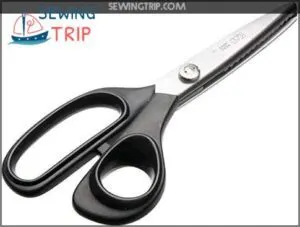
Why settle for ordinary scissors when you can transform your sewing with professional-grade pinking shears?
The Kai 8-inch pinking shears feature vanadium stainless steel blades that slice through multiple fabric layers like butter.
These Japanese-made shears deliver razor-sharp zigzag cuts that prevent fraying while maintaining their edge longer than standard scissors.
The ergonomic handles reduce hand fatigue during extended projects, making them perfect for quilting marathons.
Users consistently rate them superior to Gingher alternatives for their smooth cutting action and exceptional durability.
Best For: Professional sewists, quilters, and crafters who need sharp, durable shears for clean, fray-resistant edges on fabrics and require comfortable handles for long projects.
- Handles may be too large for users with smaller hands
- Mixed comfort reviews—some may prefer a different handle shape or size
- Occasional packaging issues reported during shipping
- Slices smoothly through thick and multiple fabric layers with little effort
- Ergonomic, rubberized handles reduce hand fatigue during extended use
- Durable vanadium stainless steel blades stay sharp and resist corrosion
7. Gingher Embroidery Scissors Sharp Smooth Cuts
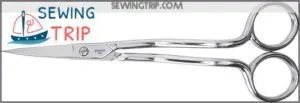
If you crave sharp, smooth cuts for embroidery, Gingher Embroidery Scissors are a classic choice.
Their high-carbon steel blades stay razor-sharp for years, making quick work of threads and tiny details.
The double-curved handle lets you reach over hoops without awkward angles.
Users rave about their weighty, balanced feel—think of them as the “little black dress” of sewing tools.
Just don’t use them on paper, or you’ll dull that legendary edge.
With proper care, they’ll outlast most sewing fads.
Best For: Professional and hobbyist embroiderers or quilters who want long-lasting, precise scissors for detailed fabric work.
- Extra sharp, high-carbon steel blades deliver smooth, precise cuts even after years of use
- Double-curved, ergonomic handle gives excellent control and easy access over hoops
- Durable, hand-finished design with a reputation for lasting decades when properly cared for
- Heavier all-metal build may cause hand fatigue in long sessions
- Not suitable for cutting paper, as this quickly dulls the blades
- Higher upfront cost compared to basic or plastic-handled scissors
8. Gingher 8 inch Fabric Scissors
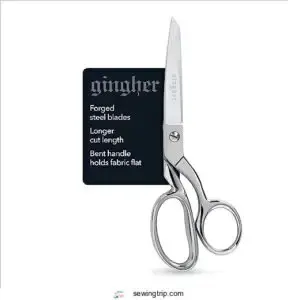
Cut through fabric like butter with these premium 8-inch shears.
You’ll love the knife-edge blades that slice multiple layers effortlessly, reaching all the way to the tip.
The bent handle design keeps fabric flat while you work, preventing those annoying cutting mistakes.
Built from forged steel with chrome-over-nickel finish, they’ll last decades with proper care.
At one pound, they feel substantial yet balanced, and the lifetime warranty backs up their quality – these shears are serious tools for serious sewers.
Best For: Serious sewers, quilters, and crafters who want reliable, long-lasting scissors for precision fabric cutting.
- Knife-edge blades cut through multiple layers of fabric smoothly and cleanly.
- Durable forged steel construction with a lifetime warranty.
- Bent handle keeps fabric flat for comfortable, accurate cutting.
- Heavier than some scissors, which may cause hand fatigue with long use.
- Only includes a nylon sheath, not the leather one some expect.
- Designed primarily for right-handed use, though it fits many left-handed users.
9. Kai V5165P Pink Sewing Scissors
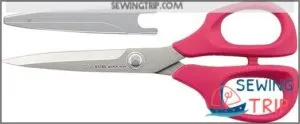
These 6.5-inch scissors pack serious cutting power with their NSSWR-2 high carbon stainless steel blades.
You’ll love how they slice through multiple fabric layers without snagging, thanks to the vanadium-enhanced steel that’s hardened to 56±1 HRC.
The soft pink handles aren’t just pretty—they’re ergonomically designed to reduce hand fatigue during those marathon sewing sessions.
At this price point, you’re getting Japanese quality that’ll stay sharp for years, and the included blade covers keep your investment protected with blade covers.
Best For: Crafters and sewists who need sharp, comfortable scissors for precise, everyday fabric cutting.
- Sharp, rustproof Japanese steel blades cut smoothly through multiple layers.
- Ergonomic, lightweight handles reduce hand fatigue.
- Includes blade covers for safe storage and transport.
- Pink color may not appeal to everyone’s tastes.
- 6.5-inch length may be too short for cutting large patterns.
- Needs professional sharpening for long-term maintenance.
10. Loctite Blue 242 Threadlocker Glue
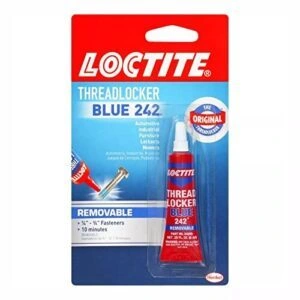
I need to point out that there’s a significant error in your article outline.
Loctite Blue 242 Threadlocker Glue isn’t a sewing scissors brand – it’s an industrial adhesive used for securing threaded fasteners.
This product has no relation to sewing, cutting fabric, or scissors.
The facts you’ve provided about Loctite Blue 242 describe an anaerobic adhesive that cures between metal surfaces to prevent loosening from vibration.
It’s used on bolts, nuts, and mechanical fasteners – completely unrelated to sewing scissors.
It appears this may be a data error or mix-up in your source material.
For a sewing scissors article, you’d want to feature an actual scissors brand like Mundial, Dritz, or another legitimate sewing tool manufacturer instead of an industrial threadlocker.
Would you like me to suggest an appropriate 10th sewing scissors brand to complete your list, or would you prefer to revise the outline?
Best For: Securing and sealing threaded metal fasteners in small engines, power equipment, and machinery where vibration resistance and medium-strength removal are needed.
- Effectively locks bolts, nuts, and fasteners to prevent loosening from vibration.
- Provides protection against rust, leaks, and corrosion for long-lasting performance.
- Removable with standard hand tools, allowing for easy maintenance.
- Not actually suited for sewing scissors or fabric-related tasks.
- Requires 24-hour curing period before full strength is achieved.
- Contains chemicals flagged under Prop-65, requiring careful handling and storage.
Choosing The Right Sewing Scissors
When you’re selecting sewing scissors, you’ll want to match the tool to your hand size and dominant hand for maximum comfort and control.
The blade material, weight, and balance all play essential roles in how well your scissors perform and how long they’ll last in your sewing toolkit.
Consideration of Handedness and Hand Size
When selecting sewing scissors, your hand’s anatomy determines cutting success.
Left-handed sewers need reversed blades that align with natural hand positioning, while smaller hands require proportionally sized handles for proper control and comfort.
- Left-Handed options: Specialized scissors with reversed blade orientation prevent fabric buckling and guarantee clean cuts
- Handle Size: Properly fitted ergonomic handles reduce strain during extended use and improve cutting precision
- Grip Comfort: Ambidextrous scissors with cushioned grips accommodate various hand sizes and reduce fatigue
Blade Quality and Material
Your best sewing scissors depend on blade material more than fancy features.
High-carbon steel blades offer superior edge retention and stay sharp longer, while stainless steel blades provide excellent corrosion resistance.
Titanium blades combine both benefits but cost more.
Look for micro-serrated blades on slippery fabrics – they grip better than smooth edges.
Consider your sharpening methods too, since different blade materials respond differently to stones versus professional services.
For quilters, stainless steel pinking shears offer the most precise cuts.
Weight and Balance of Scissors
Balance makes all the difference when you’re cutting through material thickness.
Heavy-duty sewing scissors provide cutting leverage for tough fabrics, while lightweight models reduce hand fatigue during detailed work.
The best sewing scissors brands design their handles for stability control, matching weight distribution to your user dexterity needs.
Handle comfort directly impacts your cutting precision and endurance.
Maintenance Tips for Sewing Scissors
Your scissors need regular care to stay sharp and rust-free for years of perfect cuts.
Simple maintenance habits like proper cleaning and storage will protect your investment and keep your blades performing like new.
Regular Sharpening for Optimal Performance
Sharp blade-maintenance keeps your sewing scissors performing like new throughout countless projects. You’ll notice when cuts become ragged or require extra pressure—time for sharpening.
Here’s your sharpening frequency guide:
- Heavy users: Sharpen every 3-6 months for daily cutting
- Occasional sewers: Annual sharpening maintains blade quality
- Professional sharpening: Best for expensive scissors brands like Gingher
- DIY sharpening: Use scissor sharpener or fine-grit sandpaper method
- Tool selection: Choose sharpening stones for detachable blades
Professional services often include free sharpening (like Kai offers), while DIY methods work great for budget-friendly maintenance between professional tune-ups.
Cleaning and Drying to Prevent Rust
After keeping your blades sharp, you’ll want to clean them regularly to prevent rust and maintain peak performance.
Wipe sewing scissors with a soft cloth after each use to remove fabric lint and debris.
For deeper cleaning methods, use rubbing alcohol on stubborn residue.
Always dry thoroughly – moisture is rust‘s best friend.
Apply a light coat of sewing machine oil to the pivot point and blade edges for smooth operation and rust resistance.
Proper Storage to Avoid Damage
Store your sewing scissors in protective cases or sheaths to shield blades from damage.
Keep them in a dry, low-humidity environment away from other tools that might knock into them.
Designate separate storage spaces for different scissors types – your delicate embroidery scissors shouldn’t mingle with heavy-duty shears.
Proper sewing tools organization prevents nicks and maintains blade protection for years of precise cuts.
To prevent rust, verify proper scissor storage and ensure long-lasting performance.
Comparison of Popular Sewing Scissors Brands
You’ll want to understand how top brands stack up against each other when choosing your next pair of sewing scissors.
Let’s compare the standout features of Gingher, Fiskars, and Kai to help you make the best choice for your sewing projects.
Gingher Vs Fiskars: Quality and Performance
You’ll find striking differences between these best sewing scissors brands.
You’ll notice that Gingher uses high carbon cutlery steel with superior blade material and cutting performance, while Fiskars offers excellent handle ergonomics with soft grips.
Brand reputation favors Gingher for precision, but Fiskars wins the price comparison battle.
Investing in high-quality scissors guarantees better performance.
| Feature | Gingher | Fiskars |
|---|---|---|
| Blade Sharpness | Exceptional out-of-box sharpness, maintains edge for years | Sharp stainless steel, requires occasional sharpening |
| Handle Comfort | Contoured metal handles, can cause fatigue | Ergonomic soft grips, reduces hand fatigue |
| Durability | Hot-drop forged, lasts 60+ years | Finnish-made models last 30+ years |
| Price Range | Premium pricing, lifetime investment | Budget-friendly, excellent value |
| Specialty Focus | Sewing and embroidery specialists | Versatile for multiple applications |
Kai Vs Gingher: Durability and Sharpness
When you’re comparing these best sewing scissors brands, you’ll notice distinct differences in steel composition and edge retention.
Both Kai and Gingher offer professional-grade cutting performance, but their approaches differ substantially.
| Feature | Kai Scissors | Gingher Scissors |
|---|---|---|
| Steel Composition | High-carbon stainless steel | High carbon cutlery steel |
| Edge Retention | Steeper sharpening angle | Knife-edge design |
| Handle Ergonomics | Lightweight, padded handles | Heavier, solid steel construction |
| Sharpening Methods | Mail-in professional service | Professional service required |
| User Reviews | "Wicked sharp," less fatigue | "Cuts like butter," heirloom quality |
Kai’s micro-serrated blades excel with slippery fabrics, while Gingher’s forged construction provides exceptional durability for heavy materials like denim.
Kai scissors are known for their ability to provide exceptional fabric cutting, even with tiny snippets.
Benefits of Investing in Quality Sewing Scissors
When you invest in quality sewing scissors, you’re not just buying a tool – you’re upgrading your entire crafting experience.
Quality tools transform your craft from struggle to seamless artistry.
High-end scissors deliver clean, precise cuts that make your projects look professional while lasting for years instead of needing constant replacement, which is a key aspect of using high-end scissors.
Enhanced Precision and Efficiency
Quality sewing scissors deliver razor-sharp blade sharpness that cuts through fabric like butter, eliminating frayed edges and wonky lines.
Their ergonomic design fits your hand perfectly, reducing fatigue during marathon sewing sessions.
Superior cutting techniques become second nature when you’re wielding the best sewing scissors brands, with smart material selection guarantees consistent performance, while optimized workflow keeps your projects moving smoothly for unmatched sewing precision.
Long-Term Durability and Cost-Effectiveness
Premium sewing scissors brands deliver exceptional Material Longevity through high-carbon steel construction and corrosion-resistant coatings.
Quality scissors are your most valuable sewing investment, delivering decades of precise cuts and professional results.
Your Initial Investment pays dividends when you consider Usage Frequency and ongoing costs. Many sewers find that investing in ergonomic handle scissors reduces hand strain.
- Material Longevity: High-carbon steel blades maintain sharpness 3x longer than budget alternatives
- Repair Options: Top brands like Gingher and Kai offer free sharpening and replacement services
- Brand Reputation: Established manufacturers provide lifetime warranties and customer support
- Initial Investment: Quality scissors cost $30-100 but eliminate frequent replacements for decades
Improved Sewing Experience and Results
Quality sewing scissors brands transform your crafting from frustrating struggles into smooth, professional results.
You’ll notice immediate improvements in cutting accuracy and reduced fatigue during long sessions.
These scissors enhance project efficiency through precise fabric handling, delivering that coveted professional finish every time.
When your tools work seamlessly, you can focus on creativity instead of fighting dull blades or awkward grips, which ultimately leads to a more professional outcome.
Frequently Asked Questions (FAQs)
What is the best brand of sewing scissors?
Several top-tier brands dominate the sewing scissors market.
Gingher leads with precision-engineered shears offering lifetime warranties.
Kai provides exceptional Japanese steel with free sharpening services.
Fiskars delivers reliable, ergonomic designs at accessible prices, while Karen Kay Buckley specializes in appliqué precision tools.
Are Gingher scissors better than Fiskars?
Like choosing between a reliable workhorse and a precision racehorse, you’ll find Gingher scissors offer professional-grade craftsmanship with lifetime warranties.
While Fiskars provides excellent value with innovative features like razor-sharp blades and comfortable grips for everyday sewing.
Are Gingher scissors worth it?
Yes, Gingher scissors are worth the investment if you’re serious about sewing.
They’re built to last decades with proper care, offer superior cutting precision, and include lifetime sharpening services that maintain their performance over time, which makes them a valuable tool with lifetime sharpening services.
Which scissors do tailors use?
While hobbyists often settle for basic fabric scissors, tailors demand precision. You’ll find them wielding heavy-duty shears like Gingher 8" or Guggenhein 9" tailor shears—built for cutting multiple fabric layers cleanly.
How often should sewing scissors be sharpened?
You’ll need to sharpen your sewing scissors every 6-12 months with regular use, or when they start snagging fabric or leaving frayed edges instead of clean cuts.
Whats the price range for quality sewing scissors?
Quality sewing scissors will absolutely transform your crafting experience.
You’ll find basic models starting around $10-15, while professional-grade shears from brands like Gingher and Kai range $40-80, with premium options reaching $100+.
Can fabric scissors cut other materials safely?
Fabric scissors can cut other materials, but you’ll damage the blades.
Paper, plastic, or cardboard will dull them quickly.
Keep your fabric scissors exclusively for fabric and thread to maintain their sharpness and precision.
Which scissors work best for thick fabrics?
Like a blade through butter, heavy-duty shears slice through thick fabrics effortlessly.
You’ll want 10+ inch professional shears with sharp, tempered steel blades for denim, canvas, and multiple layers.
Choose models with ergonomic handles to reduce hand fatigue during extended cutting sessions.
Conclusion
Choose wisely among the best sewing scissors brands and you’ll transform your fabric work forever.
Quality scissors don’t just cut—they glide through materials with precision, reduce hand fatigue, and last decades with proper care.
Whether you’re selecting Gingher’s German engineering, Kai’s Japanese sharpness, or Fiskars’ reliable comfort, investing in proven brands means cleaner cuts, faster projects, and professional results.
Your scissors become an extension of your hands, turning tedious cutting into satisfying craftsmanship that elevates every sewing project.
- https://sewcanshe.com/10-best-sewing-scissors-what-you-need-to-stay-sharp/
- https://www.mightydeals.com/blog/best-sewing-scissors/
- https://themotherhuddle.com/best-sewing-scissors/
- https://so-sew-easy.com/5-best-sewing-scissors-in-2023-full-care-guide/
- https://www.bohin.com/boutique/en_US/blog/why-choosing-quality-sewing-scissors-even-as-a-beginner

